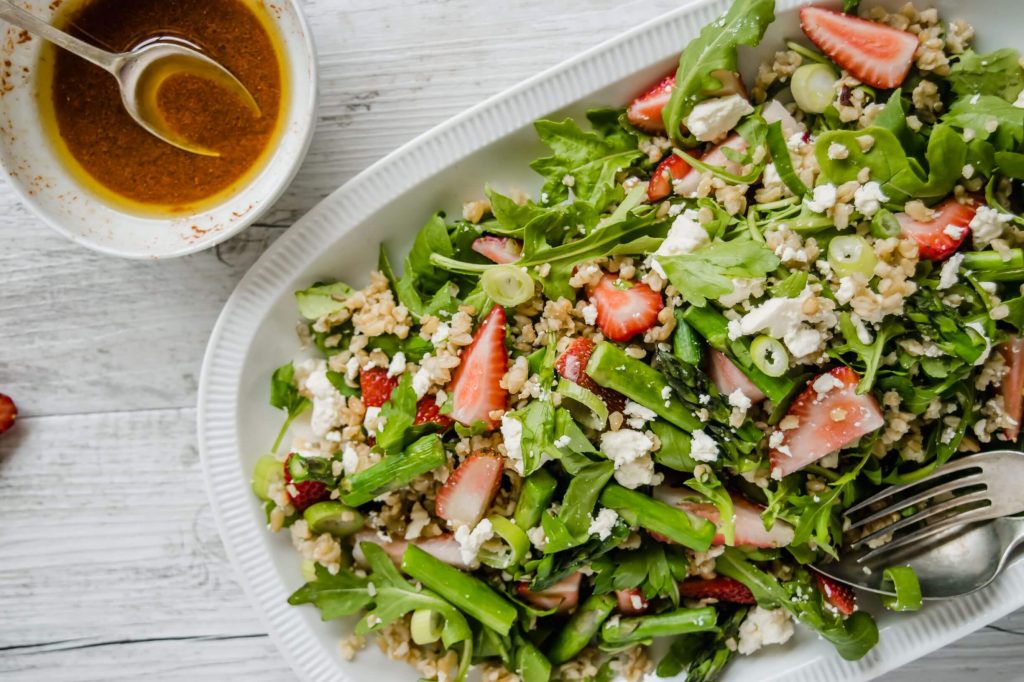It’s now common knowledge that leafy greens are really good for us. But leafy greens and salads are so much more than just the ‘lighter’ option for lunch. These little leaves are a nutritional powerhouse. There are so many types of leafy greens available, but some of the best, most accessible and cheapest are good ol’ spinach, rocket and mixed leaves for salads you can find at your local supermarket or greengrocer.

So what benefits do these little green leaves actually provides? Well, here are 7 reasons you need to include more leafy greens to your diet:
#1 Antioxidants
Vitamin C, lutein and zeaxanthin are all antioxidants that are loaded into a range of leafy greens. They help to remove free radicals from the body, assist with inflammation, immune response and, more specifically, the antioxidants found in leafy greens help to decrease formation of cataracts and muscle degeneration.
#2 Vitamin K
Vitamin K is vital for blood clotting along with strong bones and cell growth. All leafy greens contain high levels of vitamin K as it’s found in chlorophyll, which gives them their green colour. Eating just ½ cup of raw spinach provides us 91% of our daily value of vitamin K.1
#3 Loaded with Fibre
Leafy greens are a valuable source of insoluble fibre. Insoluble fibre is often called roughage; essentially it doesn’t completely break down in your digestive system but instead stimulates the digestive tract and helps food move through your intestines.2 An added benefit is insoluble fibre can help to prevent constipation and more serious diseases such as diverticular disease which is caused by the inflammation of the digestive track.

#4 Folate
Folate is a type of B vitamin (Vitamin B9 to be exact) and our bodies can’t produce it, so we have to rely on food source to get enough. The good news is that leafy greens are packed with this vitamin, so stock up! Folate plays a vital role in cardiovascular health, the digestive process and more commonly in spinal growth during the fetal stage. This is a key reason why pregnant women are advised to take supplements to ensure they get enough. Folate has also been linked with warding off depression!
#5 Vitamin E
Vitamin E is found in most leafy green vegetables. It’s one of the best ways to get your daily level of vitamin E, as there is a high risk of overdosing when using supplements.3 Vitamin E is vital for good eyesight as well as protecting cells from damage and hence has been linked with lowering the risk of various diseases from heart disease to cancer. It also helps in the production of various hormones required for normal bodily function.

#6 Loaded with minerals
Leafy greens are packed full of minerals, especially potassium and magnesium. Potassium is important for cell function in the body, and is vital in heart function and the contraction of muscles. Magnesium is important for muscle recovery as well as lowering blood pressure, easing severity of migraines, and decreasing of type 2 diabetes and osteoporosis.4 Leafy greens also contain calcium, which is important for bone health. But it is important to note, calcium in vegetables is not as bioavailable (or as easily used by the body) as calcium in dairy products.
#7 Nutrient dense & low in calories
Lastly, you can’t beat how much nutrition they pack with such low calories. It is no wonder leafy greens are often recommended for weight loss. But there is one more reason they are great to include in your diet when you are trying to lose weight. A study done at the University of Cambridge suggests that the inorganic nitrates found in Leafy greens help to convert white fat cells into brown fat cells that actually help to burn calories.5
If that isn’t reason enough to start reaching for the leafy greens in the supermarket, why not check out some of our delicious recipes to get you started.

References
- Bruso, Jessica. “How Much Vitamin K in a Half Cup of Spinach in Micrograms?” Healthy Eating | SF Gate, http://healthyeating.sfgate.com/much-vitamin-k-half-cup-spinach-micrograms-4934.html. Accessed 02 December 2018.
- Marie, Joanne. “Soluble & Insoluble Fiber in the Functioning of the Bowel.” Healthy Eating | SF Gate, http://healthyeating.sfgate.com/soluble-insoluble-fiber-functioning-bowel-3503.html. Accessed 04 December 2018
- Mayo Clinic Staff. 2018. Vitamin E. Mayo Clinic, https://www.mayoclinic.org/drugs-supplements-vitamin-e/art-20364144. Accessed 02 December 2018.
- National Institutes of Health. 2016. Magnesium – Fact Sheet for Consumers. U.S. Department of Health and Human Services. https://ods.od.nih.gov/factsheets/Magnesium-Consumer/, Accessed 02 December 2018
- Roberts L. D, 2015. Does inorganic nitrate say NO to obesity by browning white adipose tissue? Adipocyte 4 (4): 311-314
